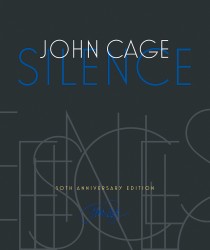 Silence: Lectures and Writings – 50th Anniversary Edition
Silence: Lectures and Writings – 50th Anniversary Edition
by John Cage
Wesleyan University Press
310 pages; $30.00 US
This special edition of American composer John Cage’s Silence celebrates two milestones in 20th century music — the 50th anniversary of Cage’s first and still most influential book, and the 100th anniversary of his birth.
Throughout the writings and lectures gathered here, Cage is looking for various ways to say that all sounds are material for music. “Silence, like music, is non-existent,” he writes. “There always are sounds. That is to say, if one is alive to hear them.” When Silence was first published, the impact was explosive. Today, many of Cage’s most controversial ideas have become commonplace. But his probing questions about sound, silence and life in general resonate just as intensely, and his answers still open doors. Reading him today we realize that the opportunities for musical experiment he offers have yet to be fullyexplored.
Cage is an irrepressible storyteller, and he embellishes these writings with stories. In fact, one of the most well-known pieces here, Indeterminacy, is nothing but a series of stories. Many of his stories are exceptionally funny, some are delightfully absurd, a number are poignant, and a few are simply baffling. But they all hit home. In Edgard Varèse he describes a visit to his Aunt Marge. “She was doing her laundry. She turned to me and said, ‘You know? I love this machine more than I do your Uncle Walter.’” Then later, in Indeterminacy, he reveals that there is something more going on here when he writes, “Uncle Walter insisted, when he married her, that Aunt Marge, who was a contralto, should give up her career.”
In Composition as Process Cage takes inquisitiveness to new extremes by asking an extended sequence of questions such as, “Why do I have to go on asking questions? Is it the same reason I have to go on writing music?”. Like everything else here, these questions add up to something powerful.
For me, the actual beginningof this book is at the very end, when, in Music Lovers’ Field Companion, he describes his joy in performing 4’33” (which he refers to here as “my silent piece”) all alone in a field where he has been gathering mushrooms. “The second movement,” he writes, “was extremely dramatic, beginning with the sounds of a buck and a doe leaping up to within ten feet of my rocky podium.”
This edition has been reprinted with care, using the original typeface and layout. The only difference from the original, apart from the cover design, is the addition of a perceptive and appropriately provocative introduction by composer, critic and Cage expert Kyle Gann, who writes, “He thought his way out of the twentieth century’s artistic neuroses and discovered a more vibrant, less uptight world that we didn’t realize was there. Silence is the traveler’s guide to that world.”
Concert Note: Soundstreams presents “So Percussion: Cage @ 100” on Friday March 2, 8pm at Koerner Hall, with a pre-concert chat at 7pm. The programme includes 4’33”.
A conference on John Cage, “The Future of Cage: Credo,” will be held at the Graduate Centre for the Study of Drama at the University of Toronto from October 25 until October 28, 2012. Further information is available at www.humanities.utoronto.ca/event details.



